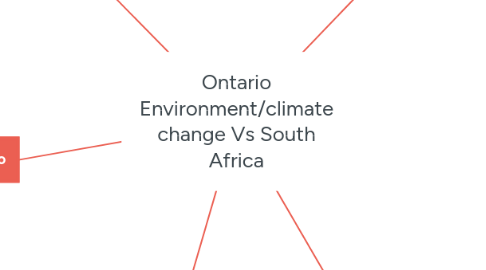
1. South Africa
1.1. Documents and regulations
1.1.1. climate change is likely to cause growing numbers to migrate from Africa’s heartlands towards Europe or southwards towards South Africa.
1.1.2. spread of many tropical diseases including malaria, dengue fever, cholera and dysentery.
1.1.3. human rights organizations are suggesting that more migrants could be coming to South Africa, as climate and economic conditions worsen in many African countries.
1.2. Climate change and migrations in South Africa
2. Ontario
2.1. Documents and regulations
2.1.1. Liberal Government made a plan for the climate change issue. This plan imposes carbon pricing across Canada.
2.1.2. levels of government are targeting changes in the greenhouse gas emissions and change for climate. The report concludes with stating that Canada is on the right track to defeat its emissions target by 2020, but more action is needed to reach the agreement by 2030.
2.2. Liberal climate plans not enough to meet 2030 emissions target, new report shows | The Star
3. Analysis Question
3.1. Cause and consequence
3.1.1. Vector borne diseases
3.2. Continuity and change
3.2.1. South Africa aims to limit emissions and adapt to climate change through measures included in its intended nationally determined contribution (INDC) to the Paris conference, such as:
3.2.1.1. the successful national Renewable Energy Independent Power Producer Procurement Programme (REI4P) decarbonised electricity by 2050 carbon capture and storage electric vehicles and hybrid electric vehicles a long-standing plan for the introduction of a carbon tax the development of a national adaptation plan.
3.2.2. Canada: Clean electricity, buildings, transportation, industry, forestry, agriculture and waste, short-lived climate pollutants (SLCPs), methane regulations for the oil and gas sector.
3.2.2.1. Guidance on carbon pollution pricing benchmark, federal carbon pricing backstop.
3.3. Canada’s action on climate change - Canada.ca
3.4. South Africa - Climate Action - European Commission
4. South African Category of analysis
4.1. Causes:
4.1.1. Very hot weather
4.1.2. Droughts are longer and harder
4.1.3. Rainfall: heavier and cause flooding
4.2. Demogrpahics:
4.2.1. unemployment is roughly 27%
4.2.2. household consumption: 59.8% government consumption: 20.7% investment in fixed capital: 20% investment in inventories: -0.4% exports of goods and services: 26.9% imports of goods and services: -27% (2017 est.)
4.2.3. agriculture: 2.8% industry: 29.7% services: 67.5% (2017 est.)
4.2.4. Electricity access: population without electricity: 7,700,000 electrification - total population: 85% electrification - urban areas: 90% electrification - rural areas: 77% (2013)
4.2.4.1. Natural gas - production: 1.1 billion cu m (2015 est.) country comparison to the world: 66 Natural gas - consumption: 8.66 billion cu m (2015 est.)
4.3. Economic
4.3.1. Middle income
4.3.1.1. well developed energy and transport system
4.3.2. Unemployment, inequality and poverty amongst the highest in the world
5. Ontario Category of analysis
5.1. https://www.cia.gov/library/publications/the-world-factbook/geos/sf.html
5.2. Causes:
5.2.1. Community damages from storm damage, building and infrastructure damage
5.3. Demographics:
5.4. Economic
5.4.1. GDP - composition, by end use: household consumption: 58.1% government consumption: 20.9% investment in fixed capital: 22.8% investment in inventories: 0.3% exports of goods and services: 31.4% imports of goods and services: -33.6% (2017 est.)
5.4.2. GDP - composition, by sector of origin: agriculture: 1.7% industry: 28.1% services: 70.2% (2017 est.)
5.4.3. Electricity - production: 643.2 billion kWh (2015 est.) country comparison to the world: 7 Electricity - consumption: 516.6 billion kWh (2015 est.) country comparison to the world: 7

